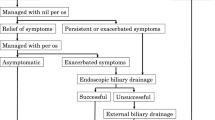Abstract
Endoscopic retrograde cholangiopancreatography examinations were prospectively analyzed to determine whether anatomical variations of ductal systems have a role in the pathogenesis of cholecystolithiasis and choledocholithiasis. Included were 140 normal examinations (control group), 102 patients with cholecystolithiasis, and 68 patients with choledocholithiasis (primary stones in the common bile duct). Low entry of the cystic duct was observed frequently in patients with cholecystolithiasis (15.7% vs. 2.1% in control, p < 0.01). No preferential type of course of the cystic duct was observed in patients with cholecystolithiasis and choledocholithiasis. Separate openings of the bile and pancreatic ducts were significantly prevalent in patients with choledocholithiasis (53.5% vs. 30.6% in control, p < 0.01). Common channel was significantly short in patients with cholecystolithiasis. Incidence of juxtapapillary duodenal diverticula was significant in patients with choledocholithiasis. These observations suggest that some of the pancreatobiliary ductal anatomy may be closely implicated in the development of gallstone diseases.
Similar content being viewed by others
References
Charels K, Klöppel G. The bile duct system and its anatomical variations. Endoscopy 1989;21:300–308
Benson EA, Page RE. A practical reappraisal of the anatomy of the extrahepatic bile ducts and arteries. Br J Surg 1976:63:853–860
Nowak A, Nowakowska-Dutawa E, Rybicka J. Patency of the Santorini duct and acute biliary pancreatitis: a prospective ERCP study. Endoscopy 1990;22:124–126
Agrawal RM, Brodmerkel GJ Jr. Choledocal cyst presenting as pancreatitis. Am J Gastroenterol 1979;71:408–411
Stringel G, Filler RM. Fictitious pancreatitis in choledochal cyst. J Pediatr Surg 1982;17:359–361
Todani T, Tabuchi K, Watanabe Y, Kobayashi T. Carcinoma arising in the wall of congenital bile duct cysts. Cancer 1979:44:1134–1141
Kimura K, Ohto M, Saisho H, Unozawa T, Tsuchiya Y, Morita M, Ebara M, Matsutani S, Okuda K. Association of gallbladder carcinoma and anomalous pancreaticobiliary ductal union. Gastroenterology 1985:89:1258–1265
Misra SP, Gulati P, Thorat VK, Vij JC, Anand BS. Pancreaticobiliary ductal union in biliary diseases. Gastroenterology 1989;96:907–912
Lygidakis NJ. Incidence and significance of primary stones of the common bile duct in choledocholithiasis. Surg 1983;157:434–436
Kubota Y. Duplication of the cystic duct detected by endoscopic retrograde cholangiopancreatography. Endoscopy 1991:23:308–309
Pomeranz IS, Shaffer EA. Abnormal gallbladder emptying in a subgroup of patients with gallstones. Gastroenterology 1985;88:787–791
Doty JE, Pitt HA, Kuchenbecker SL, DenBesten L. Impaired gallbladder emptying before gallstone formation in the prairie dog. Gastroenterology 1983;85:168–174
Toouli J, Greenen JE, Hogan WJ, Dodds WJ, Arndorfer RC. Sphincter of Oddi motor activity: a comparison between patients with common bile duct stones and controls. Gastroenterology 1982;82:111–117
Lygidakis NJ. Incidence of bile infection in patients with choledocholithiasis. Am J Gastroenterol 1982;77:12–17
Cetta FM. Bile infection documented as initial event in the pathogenesis of brown pigment biliary stones. Hepatology 1986;6:482–489
Leuschner J, Baumgartel H. Gallstone dissolution in the biliary tract: in vitro investigations of inhibiting factors and special dissolution agents. Am J Gastroenterol 1982:77:222–226
Kennedy RH, Thompson MH. Are duodenal diverticula associated with choledocholithiasis? Gut 1988;29:1003–1006
Løtveit T, Osnes M, Larsen S. Recurrent biliary calculi: duodenal diverticula as a predisposing factor. Ann Surg 1982;196:30–32
Hall RI, Ingoldby CJH, Denyer ME. Periampullary diverticula predispose to primary rather than secondary stones in the common bile duct. Endoscopy 1990;22:127–128
Viceconte G, Viceconte GW, Bogliolo G. Endoscopic manometry of the sphincter of Oddi in patients with and without juxtapapillary duodenal diverticula. Scand J Gastroenterol 1984;19:329–333
Ponce J, Garrigues V, Sala T, Pertejo V, del Val A, Hoyos M. Motor pattern of the sphincter of Oddi in patients with juxtapapillary diverticula. J Clin Gastroenterol 1990;12:162–165
Author information
Authors and Affiliations
Rights and permissions
About this article
Cite this article
Kubota, Y., Yamaguchi, T., Tani, K. et al. Anatomical variation of pancreatobiliary ducts in biliary stone diseases. Abdom Imaging 18, 145–149 (1993). https://doi.org/10.1007/BF00198052
Received:
Accepted:
Issue Date:
DOI: https://doi.org/10.1007/BF00198052




